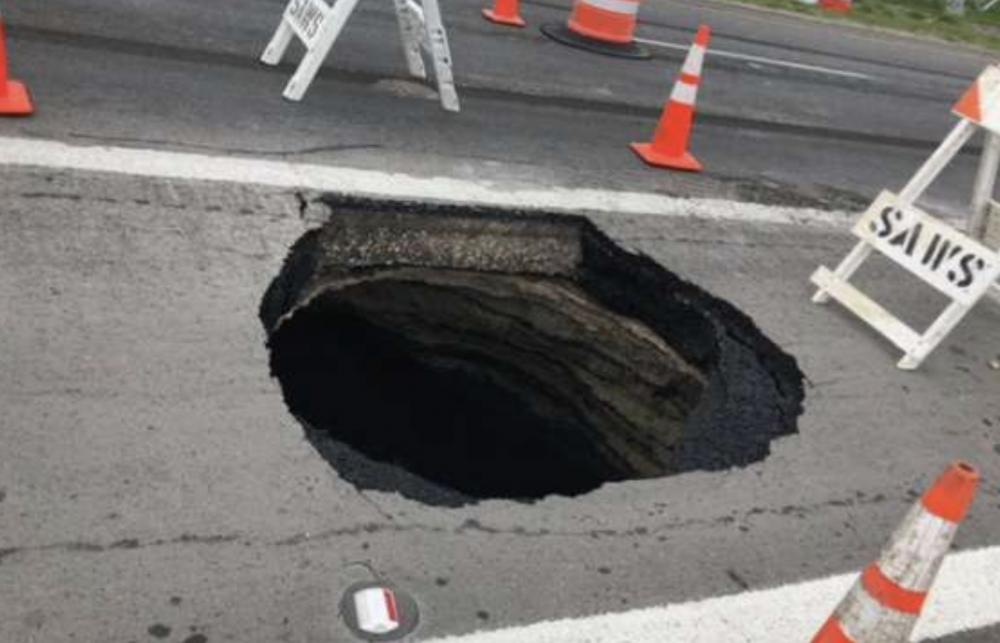You can’t see it. You may not think about it. And, then, an incident happens, and your daily life is disrupted.
The problem is fixed. Your life resumes, no longer inconvenienced. But the fix exposes a significant problem not only in your community, but in cities and towns that trace their origins to the 19th, if not the 18th centuries.
I’m referring to the aging pipes carrying sewage and stormwater beneath our streets—hidden from view and therefore ignored till too late. The time is now to look at infrastructure in our country.
The issue is a bipartisan one; nonetheless, political stalemate in the U.S. Congress likely will prevent the necessary expenditure of billions of dollars (maybe more). The problem will worsen. Sinkholes will become more common and bothersome.
Within recent months, as I was walking my dog, I noticed work being done on South Harrison Street in Easton. A sanitary sewer line installed in late 1909—110 years ago and one year after the first Model T Ford was built— required immediate repair. The project engineer said, “The sinkhole was created from the sewer lateral offset of the connection at the main, creating a void for fine sand to enter into the sanitary sewer system, undermining the ground between the road and the sewer.”
Traffic was rerouted for maybe a day. Easton Utilities did its typically efficient job replacing the more than century-old pipe without prolonged disruption on a well-traveled street.
Then, nearly two weeks ago, a storm water pipe burst in Baltimore at a busy downtown intersection at Pratt and Howard streets, creating another sinkhole that appeared to consume a Light Rail platform —and disrupting rush hour traffic. It was not a pretty picture for Baltimoreans struggling to manage their daily lives.
Towns and cities on the East Coast as well as the Rust Belt in the Midwest are showing age, at least underground. Public officials and residents cannot afford to look only at the surface. There’s plenty to worry about with what you can’t see, but surely may experience, sometimes amid dangerous and expected flooding.
Local utilities and public works departments are not sitting back awaiting the next catastrophe. They conduct video inspections that pinpoint future repair and maintenance.
The subject of repair and maintenance is not glitzy. There rarely are ribbon-cuttings and speeches by elected officials when a sewer or stormwater line is replaced. Savvy government leaders do understand, however, that ignoring infrastructure only worsens the problem.
Sinkholes can cost lives; even the word seems ominous.
According to a report prepared in May 2016 by the American Society of Civil Engineers (ASCE), “The cost of deteriorating infrastructure takes a toll on families’ disposable household income and impacts the quality and quantity of jobs in the U.S. economy.” ASCE projected that, from 2016 to 2025, “each household will lose $3,400 each year in disposable income due to infrastructure deficiencies.”
Though this financial loss is alarming, it’s important to understand that infrastructure as defined by ASCE includes aviation; bridges; drinking water; electricity; inland waterways; ports; commuter rail; roads; transit and wastewater. The report opines that businesses affected by disruptions to any infrastructure sector bear costs, which they then pass along to consumers.
This column is focused only on the underground sewage and stormwater system—unseen and disregarded by the public until a sinkhole and flooding happens. Some years ago, I recall that a pipe burst in Montgomery County, MD creating a sudden flood of water that entrapped a mother as she was driving her children to school. The picture of a helicopter rescuing the young family still haunts me.
The incident in Montgomery County brought home to me the importance of infrastructure and need for constant vigilance. The sinkhole on South Harrison Street in Easton—which could have occurred in Chestertown, Denton and Cambridge—certainly wasn’t a terrible inconvenience. Nonetheless, it struck a nerve for me.
While I realize that local, state and federal governments have many pressing problems and too little money to address of them, I recommend that we understand that a complicated and, in some cases, an aging system of pipes demands our attention.
Columnist Howard Freedlander retired in 2011 as Deputy State Treasurer of the State of Maryland. Previously, he was the executive officer of the Maryland National Guard. He also served as community editor for Chesapeake Publishing, lastly at the Queen Anne’s Record-Observer. In retirement, Howard serves on the boards of several non-profits on the Eastern Shore, Annapolis and Philadelphia.



Write a Letter to the Editor on this Article
We encourage readers to offer their point of view on this article by submitting the following form. Editing is sometimes necessary and is done at the discretion of the editorial staff.